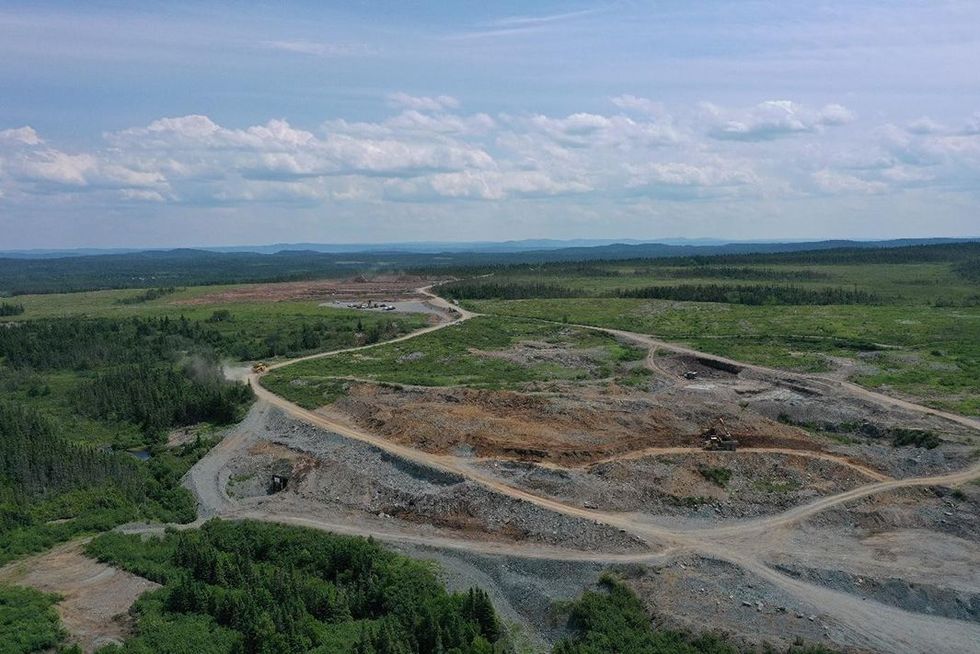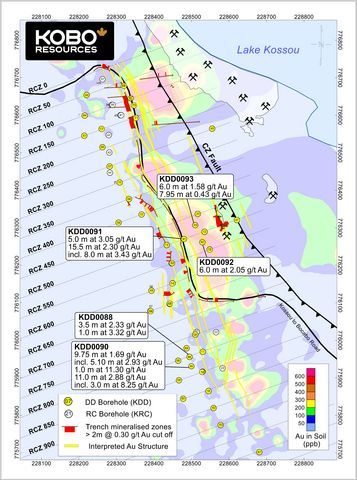Amex Exploration Inc. ("Amex or the Company") (TSXV:AMX)(FRA: MX0)(OTCQX:AMXEF) is pleased to report results from several holes targeting the depth and lateral extensions of the High Grade Zone (HGZ), a continuous high grade gold system which is immediately north of the Denise Zone (Denise), forming together the Eastern Gold Zone (EGZ) of the Perron property in northwestern Quebec, Canada as shown in Figures 1 & 2. These results significantly expand the strike length of the high grade portion of the HGZ, increasing the potential of ounce per vertical metre of the system, as well as increasing dimension of the high grade mineralization at depth. Highlights are detailed below, and a complete list of results is available in Table 1. Kelly Malcolm, V.P. Exploration of Amex Exploration, offers a quick explanation of today's results in this video reviewing the long section of the HGZ. https:youtu.be7ONwj43G1Wg
Gold mineralization at the HGZ, hosted by brecciated rhyolite of the Beaupre Block, consists of bonanza grade hangingwall and footwall veins which flank an anomalous to low grade mafic intrusive rock. Gold is in the veins and is associated with sphalerite and pyrite as shown in Figure 3. A longitudinal section of the HGZ is shown in Figure 4 and highlights include:
- Hole PE-20-217 intersected 10.55 metres of 20.88 g/t Au over the entire HGZ including a very high grade core of 1.50 metres of 144.90 g/t Au which shows homogeneous distribution of gold within the hangingwall vein including 0.50 metres of 72.55 g/t Au, 0.50 metres of 119.58 g/t Au, and 0.50 metres of 242.58 g/t Au at a vertical depth of approximately 560 metres. This intercept occurs at the western margin of the upper portion of the HGZ and significantly increases the strike length of the bonanza grade portion as shown in the longitudinal section. See Figure 4.
- Hole PE-20-197 intersected 6.65 metres of 5.89 g/t Au over the entire HGZ including 0.60 metres of 31.68 g/t Au and 0.90 metres of 19.72 g/t Au at a vertical depth of approximately 1,000 metres which expands the strike length to the East of the HGZ at depth by ~75 metres.
- Hole PE-20-187W2 intersected 7.90 metres of 13.87 g/t Au over the entire HGZ including 2.20 metres of 49.04 g/t Au which includes 0.55 metres of 106.04 g/t Au and 0.55 metres of 87.92 g/t Au at a vertical depth of approximately 1,065 metres.
Jacques Trottier, PhD Executive Chairman of Amex said, "Over the past two years our High Grade Zone has consistently produced exceptional drill results. The HGZ is continuous and predictable as indicated by the strike length expansion of ~75 metres in hole PE-20-197 as well as the expected bonanza grades encountered in hole PE-20-187W2. However hole PE-20-217 was unexpected and is very exciting to our exploration team, as it produced a very high metal factor in an area of the HGZ that was expected to be weakly mineralized, thus the western extension of the HGZ is now wide open, along with many other areas in the immediate vicinity, for additional high grade mineralization. We continue to intercept significant gold at depth as well, further expanding the footprint of the system."
Trottier continued, "Our 10th drill rig has arrived on the property ahead of schedule and we expect to drill in excess of 10,000 m a month. We have many holes pending at the lab, particularly for the Denise Zone, which we are keen to receive and release to the market."
In addition, Amex recently released an updated corporate video highlighting the advancements in the Perron Project over the past year. View it on the Amex YouTube Chanel and subscribe today.
https://www.youtube.com/watch?v=MORoqUBfmig&t=65s
Figure 1: Geology of the Perron project and known gold zones

Figure 2: Overview of the Perron Gold Corridor showing the distribution of gold mineralization across a 2.5 km strike and down to a depth of over 1.1 km. The pink spheres represent individual assays greater than 20 g/t Au demonstrating the exceptional high grade nature of the Perron Gold Corridor.

Figure 3: Photos of native gold from hole PE-20-187W2, PE-20-197 and PE-20-217 of the HGZ

Figure 4: High Grade Zone Longitudinal Section Looking South

Table 1: Assay Results from the High Grade Zone at EGZ
Hole ID | From (m) | To (m) | Length (m) | Au (g/t) | Zone | Vertical depth |
PE-20-187W2 | 1159.10 | 1167.00 | 7.90 | 13.87 | HGZ (east) | 1065m |
Including | 1164.80 | 1167.00 | 2.20 | 49.04 | ||
Including | 1164.80 | 1165.35 | 0.55 | 106.04 | ||
Including | 1165.35 | 1165.90 | 0.55 | 87.92 | ||
PE-20-193 | 607.50 | 618.35 | 10.85 | 2.43 | HGZ (east) | 550m |
Including | 609.95 | 612.00 | 2.05 | 11.71 | ||
Including | 609.95 | 610.70 | 0.75 | 27.28 | ||
Including | 610.70 | 612.00 | 1.30 | 2.72 | ||
PE-20-217 | 602.50 | 613.05 | 10.55 | 20.88 | HGZ (west) | 560m |
Including | 606.00 | 607.50 | 1.50 | 144.90 | ||
Including | 606.00 | 606.50 | 0.50 | 72.55 | ||
Including | 606.50 | 607.00 | 0.50 | 119.58 | ||
Including | 607.00 | 607.50 | 0.50 | 242.58 | ||
PE-20-197 | 1094.40 | 1101.05 | 6.65 | 5.89 | HGZ (east) | 1000m |
Including | 1094.40 | 1095.00 | 0.60 | 31.68 | ||
Including | 1095.00 | 1095.90 | 0.90 | 19.72 |
* Note that drill results are presented uncapped and lengths represent core lengths. True width is estimated to be ~75% in the HGZ with the exception of the metallurgical holes which begin with the prefix "PEM" that are estimated to be ~50%.
Geology of the Eastern Gold Zone
At the Eastern Gold Zone, Amex clearly has two different orogenic Archean gold mineralization types adjacent to each other - the High Grade Zone (HGZ) and the Denise Zone. The Denise Zone is located roughly 50 m to a 100 m to the South of the HGZ and is a shear zone type gold mineralization which consists mainly of a wide (from 5 m to more than 100 m of width) sub vertical deformation zone of highly sheared and highly silicified, sericitized and pyritized altered rhyolite. The Denise zone also has a distinctive feature consisting of heavily deformed, pinched and swells transposed quartz veins and veinlets containing various sulfide minerals, such as pyrite, pyrrhotite, sphalerite and galena, and also frequently fine grain of native free gold. The occurrence of scattered fine free native gold in the Denise Zone could explain the higher gold content of this mineralized shear zone (for example hole PE-19-83 that returned 23.91 g/t Au over 9.30 m). The HGZ is typically a bonanza vein type characterized by very high grade gold content (up to 393.33 g/t Au over 1.70 m in hole PE-19-22) usually consisting of two parallel continuous quartz veins containing multiple native coarse free gold grains located at the contact on both sides of a linear vertical mafic foliated gabbro intrusive cross cutting a massive rhyolitic host unit.
Qualified Person
Maxime Bouchard P.Geo. M.Sc.A., (OGQ 1752) and Jérôme Augustin P.Geo. Ph.D., (OGQ 2134), Independent Qualified Persons as defined by Canadian NI 43-101 standards, have reviewed and approved the geological information reported in this news release. The drilling campaign and the quality control program have been planned and supervised by Maxime Bouchard and Jérôme Augustin. Core logging and sampling were completed by Laurentia Exploration. The quality assurance and quality control protocol include insertion of blank or standard every 10 samples on average, in addition to the regular insertion of blank, duplicate, and standard samples accredited by Laboratoire Expert during the analytical process. Gold values are estimated by fire assay with finish by atomic absorption and values over 3 ppm Au are reanalyzed by fire assay with finish by gravimetry by Laboratoire Expert Inc, Rouyn-Noranda. Samples containing visible gold mineralization are analyzed by metallic sieve. For additional quality assurance and quality control, all samples were crushed to 90% less than 2 mm prior to pulverization, in order to homogenize samples which may contain coarse gold. Core logging and sampling were completed by Laurentia Exploration.
The Qualified Persons have not completed sufficient work to verify the historic information on the Property, particularly in regards to historical drill results. However, the Qualified Persons believe that drilling and analytical results were completed to industry standard practices. The information provides an indication of the exploration potential of the Property but may not be representative of expected results.
About Amex
Amex Exploration Inc. is a junior mining exploration company, the primary objective of which is to acquire, explore, and develop viable gold projects in the mining-friendly jurisdiction of Quebec. Amex is focused on its 100% owned Perron gold project located 110 kilometres north of Rouyn Noranda, Quebec, consisting of 116 contiguous claims covering 4,518 hectares. A number of significant gold discoveries have been made at Perron, including the Eastern Gold Zone, the Gratien Gold Zone, the Grey Cat Zone, and the Central Polymetallic Zone. High-grade gold has been identified in each of the zones. A significant portion of the project remains underexplored. In addition to the Perron project, the company holds a portfolio of three other properties focused on gold and base metals in the Abitibi region of Quebec and else where in the province.
For further information please contact:
Victor Cantore
President and Chief Executive Officer
Amex Exploration: 514-866-8209
Neither the TSX Venture Exchange nor its Regulation Services Provider (as that term is defined in the policies of the TSX Venture Exchange) accepts responsibility for the adequacy or accuracy of this release.
Forward-looking statements:
This news release contains forward-looking statements. All statements, other than of historical facts, that address activities, events or developments that the Company believes, expects or anticipates will or may occur in the future including, without limitation, the planned exploration program on the HGZ and Denise Zone, the expected positive exploration results, the extension of the mineralized zones, the timing of the exploration results, the ability of the Company to continue with the exploration program, the availability of the required funds to continue with the exploration and the potential mineralization or potential mineral resources are forward-looking statements. Forward-looking statements are generally identifiable by use of the words "will", "should", "continue", "expect", "anticipate", "estimate", "believe", "intend", "to earn", "to have', "plan" or "project" or the negative of these words or other variations on these words or comparable terminology. Forward-looking statements are subject to a number of risks and uncertainties, many of which are beyond the Company's ability to control or predict, that may cause the actual results of the Company to differ materially from those discussed in the forward-looking statements. Factors that could cause actual results or events to differ materially from current expectations include, among other things, failure to meet expected, estimated or planned exploration expenditures, failure to establish estimated mineral resources, the possibility that future exploration results will not be consistent with the Company's expectations, general business and economic conditions, changes in world gold markets, sufficient labour and equipment being available, changes in laws and permitting requirements, unanticipated weather changes, title disputes and claims, environmental risks as well as those risks identified in the Company's annual Management's Discussion and Analysis. Should one or more of these risks or uncertainties materialize, or should assumptions underlying the forward-looking statements prove incorrect, actual results may vary materially from those described and accordingly, readers should not place undue reliance on forward-looking statements. Although the Company has attempted to identify important risks, uncertainties and factors which could cause actual results to differ materially, there may be others that cause results not to be as anticipated, estimated or intended. The Company does not intend, and does not assume any obligation, to update these forward-looking statements except as otherwise required by applicable law.
SOURCE: Amex Exploration Inc.
View source version on accesswire.com:
https://www.accesswire.com/619286/Amex-Expands-High-Grade-Zone-Along-Strike-and-to-Depth-Delivers-up-to-14490-gt-Au-over-150-m-and-4904-gt-Au-over-220-m-at-Perron




 Hammerdown project site
Hammerdown project site

